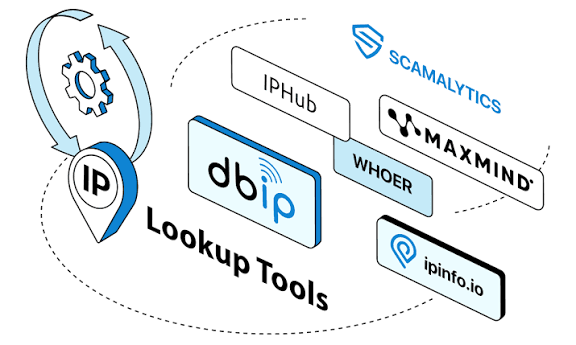
IP Lookup
Created on 16 September, 2025 • Checker tools • 95 views • 3 minutes read
IP Lookup: The Ultimate Guide to Finding and Understanding IP Addresses
IP Lookup: The Ultimate Guide to Finding and Understanding IP Addresses
Introduction to IP Lookup
Every device connected to the internet has a unique identifier called an IP address. Whether it's a computer, smartphone, or server, these addresses allow devices to communicate with one another.
IP lookup is the process of discovering detailed information about a particular IP address, such as its location, internet service provider (ISP), and type (public or private). Understanding IP lookup is crucial for network administrators, website owners, cybersecurity professionals, and even regular internet users.
This guide will explain everything you need to know about IP lookup, including types of IP addresses, lookup tools, geolocation, and best practices.
What is an IP Address?
Types of IP Addresses
IP addresses come in different formats:
- IPv4 – Consists of four sets of numbers (e.g., 192.168.1.1), most commonly used.
- IPv6 – A newer format consisting of eight groups of hexadecimal numbers (e.g., 2001:0db8:85a3:0000:0000:8a2e:0370:7334), designed to solve IPv4 shortages.
Public vs Private IP
- Public IP – Identifies devices on the internet.
- Private IP – Used within local networks like homes or offices.
Static vs Dynamic IP
- Static IP – Remains constant over time, ideal for servers.
- Dynamic IP – Changes periodically, usually assigned by ISPs.
What is IP Lookup?
Definition
IP lookup is the process of querying a database to find information associated with an IP address. This information may include:
- Geographic location (country, state, city)
- Internet Service Provider (ISP)
- Organization or company using the IP
- Connection type (DSL, fiber, mobile)
- Hostname and domain association
Importance
IP lookup is widely used in:
- Cybersecurity
- Network troubleshooting
- Website analytics
- Geolocation services
How Does IP Lookup Work?
Step 1: Identify the IP
The first step is identifying the target IP address, whether it's your own public IP, a server's IP, or a visitor’s IP on your website.
Step 2: Query a Database
IP lookup services query databases maintained by Regional Internet Registries (RIRs) like ARIN, RIPE, APNIC, and LACNIC. These databases contain registration information about IP ranges and their owners.
Step 3: Retrieve Information
The lookup tool provides details about the IP, including its location, ISP, domain, and sometimes additional metadata such as time zone and connection type.
Step 4: Analyze Results
Once the IP information is retrieved, users can analyze it for various purposes: security, compliance, marketing, or technical troubleshooting.
Tools for IP Lookup
Command-Line Tools
ping
Checks if an IP address or domain is reachable. Example: ping 8.8.8.8
traceroute / tracert
Displays the route packets take to reach an IP address. Example: traceroute 8.8.8.8 (Linux / macOS) tracert 8.8.8.8 (Windows)
nslookup
Finds the domain name associated with an IP address. Example: nslookup 8.8.8.8
Online IP Lookup Tools
- IPinfo.io – Provides geolocation and ISP details.
- WhatIsMyIPAddress.com – Shows location and type of IP.
- GeoIP2 / MaxMind – For advanced geolocation and analytics.
Uses of IP Lookup
Network Troubleshooting
IP lookup helps diagnose connectivity issues by identifying network paths and detecting unreachable devices.
Cybersecurity
Security professionals use IP lookup to detect suspicious activity, block malicious IPs, and trace attacks back to their source.
Website Analytics
Webmasters can analyze visitor locations, optimize content delivery, and improve marketing strategies using IP information.
Legal and Compliance
Organizations can ensure compliance with geographic restrictions or regulations by verifying IP locations.
Understanding IP Geolocation
Definition
IP geolocation is the process of mapping an IP address to a physical location. Accuracy is generally city-level but can vary.
Factors Affecting Accuracy
- VPN usage
- Proxy servers
- Mobile networks
- Dynamic IP addresses
Applications
- Fraud detection
- Content localization
- Personalized marketing
Common IP Lookup Challenges
Dynamic IP Addresses
Frequent changes make long-term tracking difficult.
VPNs and Proxies
These hide the actual IP, affecting geolocation accuracy.
Incomplete Database Information
Some IPs may not have up-to-date registration details.
Privacy Regulations
Legal constraints may limit the collection and display of IP-related information.
Best Practices for Using IP Lookup
- Use reliable and up-to-date IP databases.
- Combine IP lookup with other network diagnostics for better accuracy.
- Respect privacy and legal restrictions when tracking users.
- Monitor suspicious IP activity for cybersecurity.
Conclusion
IP lookup is an essential tool in the digital age. From network troubleshooting to cybersecurity, website analytics, and geolocation services, understanding how to find and analyze IP addresses is invaluable.
By leveraging reliable tools and databases, individuals and organizations can enhance security, improve website performance, and gain insights into internet traffic. Whether you are a beginner learning networking basics or an IT professional managing a large-scale network, mastering IP lookup is a key skill for understanding the digital world.
Popular posts
-
Random number generatorGenerator tools • 133 views
-
Emojis removerText tools • 129 views
-
Lorem Ipsum generatorGenerator tools • 129 views
-
Reverse lettersText tools • 121 views
-
Old English text generatorText tools • 121 views